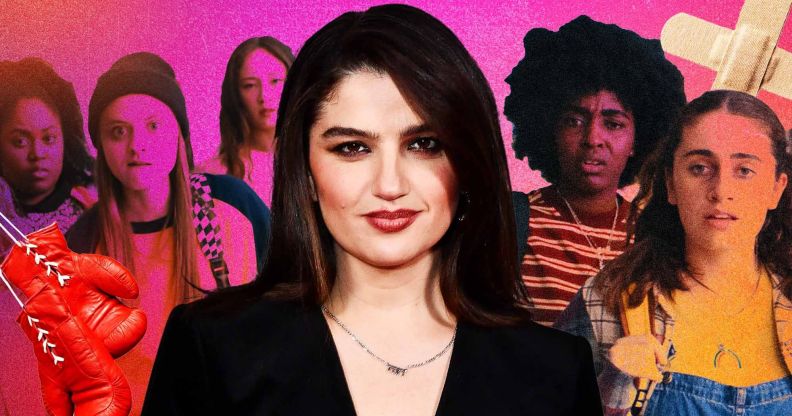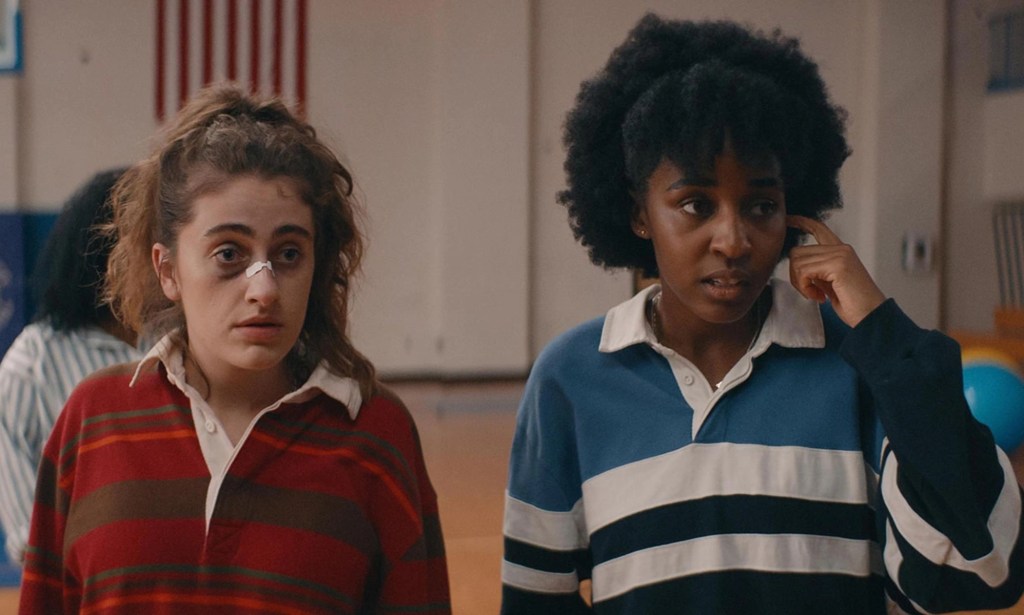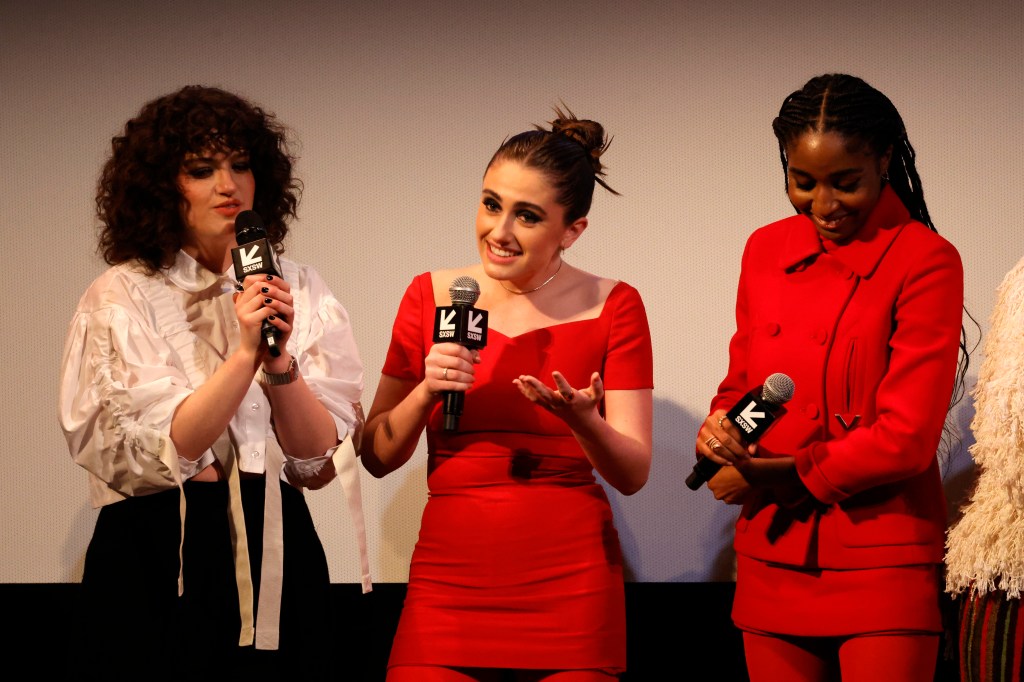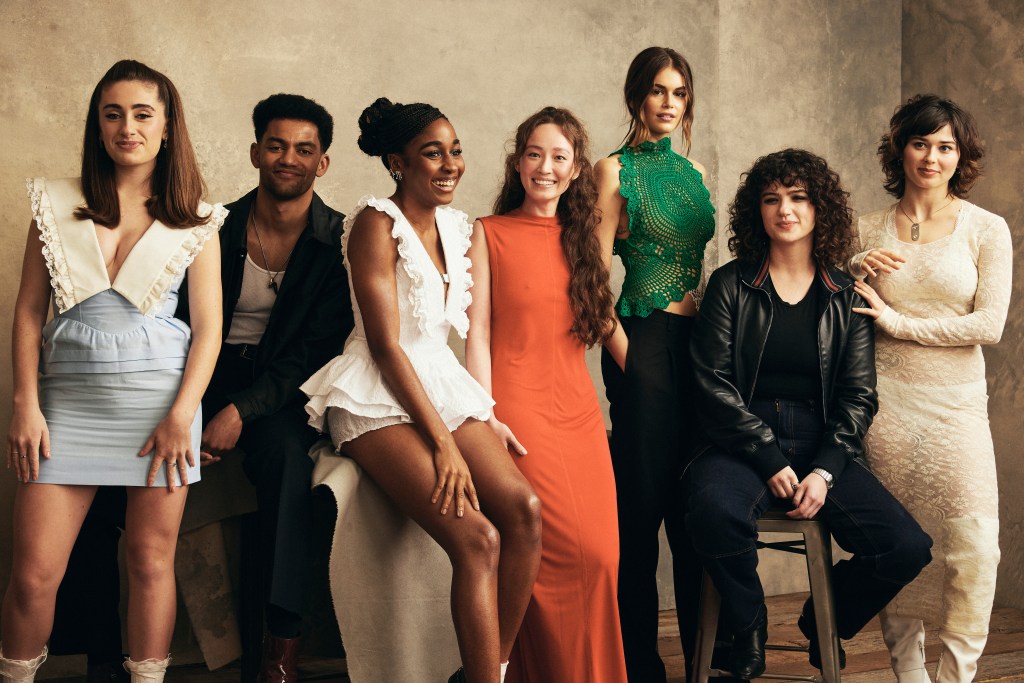‘They just want to get laid’: Bottoms director Emma Seligman on flipping the script for gay girls

Bottoms director Emma Seligman’s decision to give their characters permission to be horny and sexual was as much a personal one. (Getty Images/Orion Pictures)
Bottoms director Emma Seligman's decision to give their characters permission to be horny and sexual was as much a personal one. (Getty Images/Orion Pictures)
Emma Seligman’s fight club comedy Bottoms creates a world where queer teenage girls are free to be horny and sexual. They tell PinkNews about becoming the representation they craved growing up
If you’ve ever wondered how a young film director takes a wild idea and turns it into a box office hit, Emma Seligman is the person you need to speak to. Their 2023 film Bottoms, which tells the story of two teenage lesbian best friends who set up an after-school fight club with the goal of having sex with their cheerleaders crushes, has been called one of the “most quotable films of the decade” and heralded this generation’s Mean Girls, while breaking a box office record during its opening weekend.
It’s campy, bloody, and feels like it takes place in an entirely different universe. You couldn’t make it up. But that’s exactly what Seligman did.
The story of Bottoms’ genesis goes back seven years, when Seligman was in their final year at NYU’s Tisch School of the Arts. At the time, they were working with their friend and fellow classmate Rachel Sennott on their senior project Shiva Baby, a short film about a college student faced with a series of acutely awkward encounters at a Jewish family shiva. Seligman was struck by Sennott’s off-kilter humour and sense of ambition, and knew instantly that they wanted to collaborate with her on another film.
“The only comedy idea was just basically wanting to make a high school sex comedy for queer girls,” the 28-year-old director recalls. “She really wanted to do that and make something for flawed women. And somehow we wanted fighting or being a hero to be involved”.
The pair started writing the screenplay, with the hyper-organised Sennott introducing a timeline to keep them on track. “We would meet up once a week, and I would present her with whatever progress I had made with Shiva to get her notes, and then we would collaborate on Bottoms. And it was lovely because we got to do both at the same time.”
The project, Seligman is clear, would not have come to be without Sennott holding her accountable. “She did her Virgo thing,” she laughs. “I’m a Taurus, so I have Earth energy, but she’s on another level. Without her, we wouldn’t have made Shiva Baby. Because I was like, ‘Well, maybe we’ll do it next summer’. And she was like, ‘No, it has to be this summer’, and made me do it.”

The duo’s days spent brainstorming in their university basement paid off. Like Seligman’s award-winning debut feature Shiva Baby, which cemented their status as a wunderkind filmmaker in 2020 and also featured a star-making turn from Sennott, Bottoms isn’t afraid to push the boundaries.
The film follows woefully unpopular best friends PJ (Sennott) and Josie (Ayo Edebiri), who make a vow to lose their virginities before graduation. To do so, they start an extracurricular fight club in the name of female empowerment, with the ulterior motive of hooking up with two hot cheerleaders, Brittany (Kaia Gerber) and Isabel (Havana Rose Liu). It’s a narrative dripping in absurdity from the moment the “ugly untalented gays” are ordered to report to the principal’s office within the first few minutes of the film, and only gets more so as we encounter bone-crunching punches, exploding cars, high school wrestlers in cages and attempted murder at The Big Game. In one spectacularly-deployed needle drop, Avril Lavigne’s “Complicated” compounds the teenage angst as the fight club falls apart.
While writing Bottoms was smooth sailing for Seligman and Sennott, getting the film made was anything but. Only one production company was sold on its unique premise: Brownstone Productions, co-founded by Max Handelman and Elizabeth Banks.
“I can’t assume anything in terms of why people didn’t want it,” says Seligman. “But I think if I had to guess, I don’t think a lot of people could get their heads around the fact that it was girls fighting.” Alongside the aspect of physical violence, though – and make no mistake, Bottoms contains its fair share of gore – a conversation with producer Alison Small also made Seligman wonder if prospective investors were perplexed by the idea of queer girls trying to lose their virginities.
“She was on the phone with me, and she was like, ‘I get it. They’re gay, but they’re just horny. They just want to get laid, that’s it. It’s not about them being gay’. It made me wonder, do people not get this because it’s not about being gay? People assume gay characters and queer characters need to be in movies that centre that element. Maybe that’s part of why people didn’t get this. But I’ll never know”.

Bottoms draws from a rich canon of high school comedies that centre teens struggling with social hierarchies, drawing upon all the tropes that defined the genre in the 90s: the mean cheerleader, the gormless jock, the amoral principal. Seligman and Sennott were inspired by a smorgasbord of endlessly quotable films from the ’90s, particularly Wet Hot American Summer, Drop Dead Gorgeous, D.E.B.S, and But I’m A Cheerleader – films that have now been “studied and dissected by Gen Zers”, notes Seligman.
“These movies were either queer or often movies about bad girls and directed by queer men, you know what I mean? I think even if the movies that we watched weren’t outrightly queer, there were queer undertones.” Then there were action-driven films, such as Attack the Block and Kick-Ass, that made Seligman wonder what it would be like to see girls, rather than boys, beating each other up. “Stuff where typically teenage boys have been able to be the heroes or fight to save the day with their friends,” they explain. “It combined a lot of genres.”
Bottoms, however, is a film determined to mark itself out from its predecessors. As well as being a gleefully creative comedy, the film satirises the types of teen movies beloved by millennials, and brings them right up to date through a fantastically, unapologetically queer lens.
In Bottoms, horny teenage boys aren’t the ones exploring their sexual desires, and there’s no tired storyline about an unpopular girl and her unrequited love for the lead football player either (although it must be said that Nicholas Galitzine is perfectly cast as problematic quarterback Jeff). Rather, the film takes pleasure in elevating a story that is vanishingly rare in pop culture – that of queer girls being supremely horny.
“I think that coming of age and having sexual or romantic desire or wanting to be cool or wanting to be liked or wanting to be popular is just a universal experience,” says Seligman. “I just wanted to give our characters a chance to do that in a realistic and human way where they’re exposed and understanding of the world of sex around them”.
The decision to give their characters permission to be horny and sexual was as much a personal one. “I think I just wanted to give a younger version of me the chance to see that version of that story that I loved so much growing up. I think sometimes when you see queer teens on screen, it’s like they’re so innocent and have no sexual desires. And maybe that’s true for some people, but I couldn’t relate to those stories.”

While the sapphic losers in Bottoms are determined to get some action, Seligman was careful about how their lead characters approached their sexuality. In the film, there is no set definition of queerness; all PJ and Josie know is that they have particular desires, and are simply figuring out how to make it work for themselves.
It’s a radical premise, given that many queer films for and about queer women are preoccupied with the torment of repressed sexuality, coming out, and pure oppression.
“I think we always intended for them to be characters that didn’t talk about their sexuality,” says Seligman. “I really hesitated from ever mentioning the words gay or queer or anything having to do with sexuality. And then eventually I loosened up a little bit because queer people often talk about being queer. But I hate when I’m watching something and someone’s having to just remind the audience that they’re gay. That really bothers me.”
Alongside the caustic queer humour (“Just stay in your lane until you’re munching beaver at Wellesley!” the principal snaps at one point), Bottoms is a film that is very much told through a Gen Z lens. Sprinkled amongst all the normal teenage concerns about popularity and virginity that one would expect to find in a high school comedy, Bottoms skilfully taps into the issues that surround the internet generation in the 21st century.
From therapy speak and gun control to eating disorders, violence and intersectionality, the film provides a humorously authentic glimpse into the issues that define Gen Z without diminishing them. “I really value when people use violence for me, it’s actually one of my love languages,” says Isabel at one point in the film when the teenagers aren’t sitting in a sharing circle earnestly sharing their traumas. In another hilarious moment, Josie tells PJ, “You don’t care about feminism. Your favourite show is Entourage!”
For all the ways the film pokes fun at Gen Z, though, it also respects the way young people navigate the world, especially in regards to matters of sexuality. Granted, PJ and Josie are so desperate to “get some cooch” from the objects of their affection that they’ll take a mean right hook for it, but queerness is simply one aspect of their identity.
“I definitely took inspiration from Gen Zers and queer teenagers who I think view sexuality so much more fluidly and, at least for some, don’t see labels the way that my generation did necessarily growing up,” says Seligman. For older generations watching the film, she says, the teenagers’ attitude towards their sexuality is perhaps a reminder that things “don’t need to be so defined and spelled out” all the time.
Quite simply, Bottoms may be queer, but queerness doesn’t really matter. “It was very fun to make something totally centred on these characters, their goals and nothing else,” says Seligman. “They’re relatable, but also totally immature and shallow desires; to be liked and nothing else.”
Despite Bottoms being heralded as “one of the most encouraging box office stories of recent memory”, however, Seligman isn’t fazed by the fact that they’ve reclaimed the high school comedy for queer teens.
“I’m trying to honour a canon of camp that has come before me in queer cinema,” she explains, “but also just make something fun and silly. I hope it holds space for that.”
We can be certain of one thing from their future cinematic endeavours, though. “I just want to continue to put queer characters in genres we haven’t seen them in before, and not to have the plot centre around their queerness again and again”. There’s nothing silly about that.
Bottoms is available to stream now on Amazon Prime Video, Apple TV, and other video-on-demand platforms

